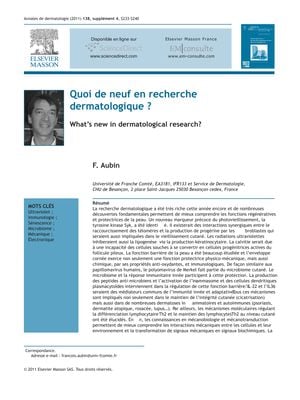What's New in Dermatological Research?
December 2011
in “
Annales de Dermatologie et de Vénéréologie
”

TLDR 2011 dermatological research found new skin aging markers, hair loss causes, skin defense mechanisms, and potential for new treatments.
In 2011, dermatological research uncovered several key findings, including the identification of Syk kinase as an early marker for UV-induced skin photodamage, the link between telomere shortening and progerin in skin aging, and the inhibition of subcutaneous lipogenesis by UV radiation. A defect in the conversion of hair follicle stem cells to progenitor cells was associated with androgenetic alopecia, rather than a loss of stem cells. The skin's barrier function was found to be multifaceted, providing physical, chemical, and immunological defense, with the cornified envelope playing a significant role. The skin microbiome, particularly the Merkel cell polyomavirus, and antimicrobial peptides contribute to this protection. Immune response mediators like IL-22 and IL-36 were identified as important for skin integrity and the regulation of inflammatory and autoimmune dermatoses. Advances in mechanobiology shed light on the conversion of mechanical to biochemical signals, and the concept of an electronic second skin was introduced. The document also discussed the role of the coxsackie and adenovirus receptor (CAR) protein in immune response and epidermal integrity, the balance between the skin's physical and antimicrobial properties, the dichotomy between commensal and pathogenic skin microbiota, and the genetic signatures in lupus. It highlighted the potential of bio-engineering in dermatology and suggested that a better understanding of the stratum corneum and antimicrobial peptides could lead to new treatments for inflammatory dermatoses. Additionally, it mentioned the evolutionary function of wrinkled fingers in wet conditions and listed various clinical trials and conferences in dermatology.







